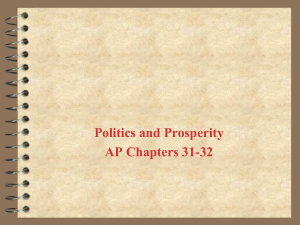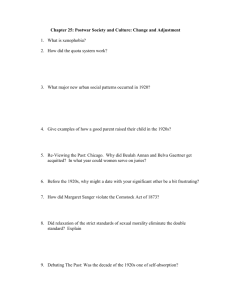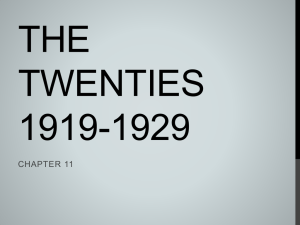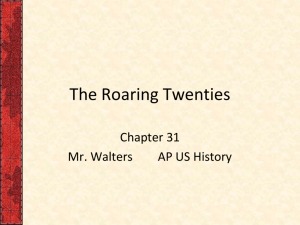Ch. 14: Politics and Prosperity (1920
advertisement
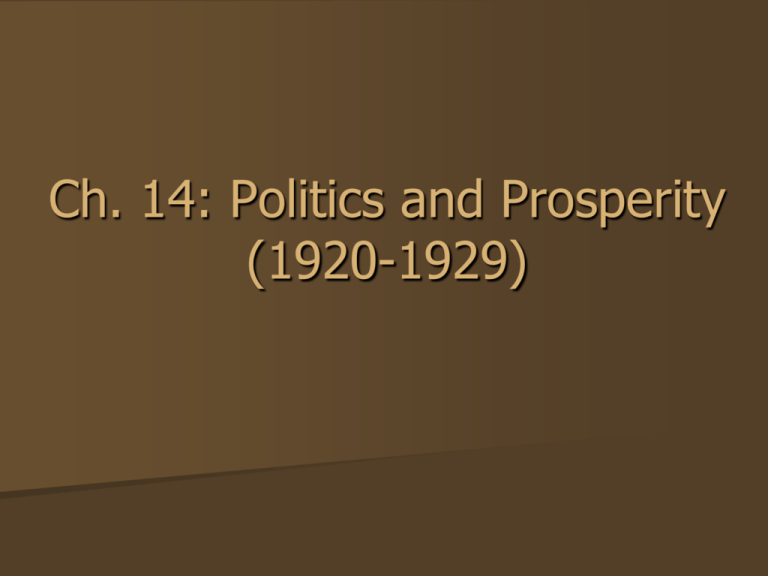
Ch. 14: Politics and Prosperity (1920-1929) Section 1: A Republican Decade The Republican Party dominated all three branches of government throughout the entire 1920s, including the Presidency. Presidents were Warren Harding, Calvin Coolidge, and Herbert Hoover. Russian Revolution 1917 Bolshevik Revolution Vladimir Lenin: Red Army Resistors: White Army The U.S. backed the Whites because the Bolsheviks threatened their business investments in Russia. Russian Revolution/Communism The Reds retained control and in 1922, the new nation became known as the Union of Soviet Socialist Republics (USSR) or Soviet Union. Communism became the official ideology of the USSR, which meant… – Government ownership of all land and property – Single political party controlled government Red Scare Americans feared Communism would spread throughout the world. The intense fear of the spreading of communism is referred to as a Red Scare. Schenck v. U.S. During WWI, Charles Schenck urged draftees not to report for duty and was convicted for breaking the espionage and sedition acts. He appealed on the premise of free speech. Supreme Court ruled that the government is justified in silencing free speech in the face of “clear and present danger”. The Palmer Raids U.S. Attorney General, A. Mitchell Palmer, set up a special force to conduct raids and arrest suspected “subversives”. Targets included suspected Communists, Socialists, and anarchists. Federal agents arrested thousands of suspected radicals without evidence. Most of the suspects were born overseas. 500+ were deported. Sacco and Vanzetti Nicola Sacco and Bartolomeo Vanzetti, two Italian, anarchist immigrants, were arrested, convicted, and sentenced to death for a murder case in Massachusetts. Many Americans believed the men to be innocent, that the men were targeted and sentenced due to their immigrant status and radical political beliefs. Labor Strikes A wave of labor strikes preceded the Red Scare of the 1920s. Many believed that Communist “agitators” were behind the labor unrest. Hindsight shows differently: inflation caused the cost of living to double after WWI, while wages had stayed the same. Boston Police Strike Boston police officers hadn’t received a raise since the start of WWI. Tried to unionize- 19 officers were fired. The entire police force went on strike. Rioting broke out immediately and there were not police to intervene. Steel and Coal Strikes In 1919, steelworkers launched a strike against the U.S. Steel Corp. 350,000 workers walked off the job. Calling it the work of communists, U.S. Steel fought hard against the strike. Thousands of African Americans were brought up from the South to fill the place of the strikers, the strike failed and the workers went back. Strikes Decline After 1920, the spike in union membership and strikes began to decline with the booming economy of the 20s. Public and governmental opposition played a role in reducing strikes, as well as the upturn of the economy. Harding Presidency Warren G. Harding became president in 1921, succeeding Woodrow Wilson. “return to normalcy” Americans were weary from WWI and the labor strikes that immediately followed, wanted “normalcy”. Foreign Policy Harding was an isolationist, he avoided political or economic alliances with foreign countries. He had opposed the League of Nations. Also called for disarmament, nations of the world to voluntarily give up weapons to “disarm” the world. Domestic Issues Increased nativism (anti-immigrant sentiment) – Religion: opposed to Catholics, Orthodox Christians or Jews. – Jobs: feared immigrants would take their jobs. – Urban conditions: blamed slums and corruption on immigrants. Harding placed a quota on immigration, greatly reduced the number of immigrants after 1922. Teapot Dome Scandal Harding’s Secretary of the Interior, Albert B. Fall, secretly gave oil-drilling rights on government oil fields in Elk Hills, California and Teapot Dome, Wyoming to private oil companies. Fall received more than $300,000 in illegal payments. Teapot Dome is considered one of the greatest scandals in American politics. Coolidge Becomes President Harding died in 1923, possibly from heart problems and stress related to Teapot Dome and other scandals. Vice President, Calvin Coolidge, became President. Coolidge and Laissez Faire “The chief business of the American people is business.” Coolidge believed in Laissez Faire business philosophy, no government involvement. Cut business taxes and deregulated industry. Kellogg-Briand Pact Frank B. Kellogg, Coolidge’s Secretary of State, made an agreement with French Foreign Minister Aristide Briand that the U.S. and France would not go to war. Over 60 countries eventually joined the pact, which proved to mean very little due to a lack of enforcement. 1928 Election Coolidge decided not to run for reelection in 1928, despite eligibility. Republicans nominated Herbert Hoover, who won the election. Section 2: A Business Boom The 1920s was marked by an economic boom, deregulation, and prosperity, until the stock market crash in 1929. A Consumer Economy Average wages rose 28 percent between 1914-1926. During the same time period, the number of millionaires in the U.S. doubled. With more income, Americans purchased more goods and services, which in turn strengthened the economy and their own wages. Buying on Credit Prior to the 20s, Americans paid cash for most items. Manufacturers began offering installment plans. Customers paid some money up front, and the rest at intervals over a period of time. Electric Power New home appliances demanded unprecedented amounts of electricity. From 1913-1917, the number of electric customers more than quadrupled. Increased the demand for new goods in the home. Advertising New forms of advertising sought to popularize new goods. Earlier advertising had listed information about the product; fabric, design, price, etc. New advertising spoke less about the product and more about the consumer, how the product would improve the consumer’s image. Rise in Productivity Electric power, new advertising, and installment plans all launched a buying spree in the 1920s. To meet demands, productivity increased. Gross National Product (GNP), the total measure of goods and services produced annually, grew by 6% each year during the 1920s. GNP had grown by less than 1% a year from 1910-1920. Henry Ford and the Automobile The first automobiles were invented in Germany in the 1880s, but were inaccessible to the public. From 1892-1920, 8 million cars were produced and sold. During the 20s alone, 15 million cars were sold, many from the innovative business model of Henry Ford. Henry Ford Originally an engineer of a lighting company, Ford spent his spare time inventing a “horseless carriage”. By 1903 he had started his own automobile company and started selling his version of the automobile, the Model T. Ford and Assembly Line Henry Ford perfected the assembly line and mass production. He did not invent the concept of an assembly line, but greatly enhanced its efficiency. At Ford Plant in Detroit, Michigan, they produced a Model T every 24 seconds. Ford built half of all the automobiles in the world from 1908-1927, 15 million total. Business Model/Fordism Henry Ford offered an unprecedented business model. In 1914, he announced he would pay workers $5/day and limit work weeks to 40 hours (5, 8 hour days) This was more than double what he had been paying ($2.34/day), or what a laborer could earn anywhere else. Business Model/Fordism Jobs at Ford became very competitive so Ford was able to demand hard work from employees. Ford was also able to greatly reduce the cost of an automobile. The combination of increasing wages while reducing costs of a finished car allowed the workers themselves to purchase Ford automobiles, causing a fullcircle economy. – This economic philosophy is sometimes called Fordism. Ford was able to reduce the cost of a Model T every year. From $825 in 1908 to $360 in 1916 Industrial Growth Automobile production became the largest manufacturing industry during the 20s. Cars became a symbol of American identity. Created new industries. – Garages, car dealerships, gas stations, motels, restaurants, road construction. – Cars also boosted the housing market by enabling an expansion of suburbia. Bypassed by the Boom The new prosperity bypassed a significant portion of the country. Unskilled laborers, immigrants, and African Americans remained poor. Farmers struggled during the 1920s. – After WWI, food prices dropped and farmers struggled to remain in business. – Many new conveniences, such as electricity, did not extend to rural areas. Section 3: Late 1920s Economy Overwhelming optimism lead many Americans into risky investments, leading to the collapse of the stock market and the Great Depression. “Wonderful Prosperity” Stock prices soared in the late 1920s. – In 1925, the value of all stocks was $27 billion. – 1929: $87 billion. Workers wages rose more than 40 percent during the decade. In 1928, the New York Times described the year as one “of unprecedented advance, of wonderful prosperity.” “Everybody Ought to Be Rich” Americans believed wealth was available even to ordinary people. John J. Raskob: stated an income of $15/week over 20 years could bring a $400/month income from investments. – “Anyone not only can be rich, but ought to be rich.” Welfare Capitalism To combat unsatisfied labor unions, many larger companies became proactive in meeting their employees’ demands. By raising wages, offering new benefits like paid vacation, health plans, and recreation programs, employers were able to strengthen company loyalty and morale. Became known as welfare capitalism. Uneven Prosperity It was mainly the rich who benefited from this success. In 1929, 0.1% of the families had incomes of over $100,000 and 34% of all national savings. 71% of families earned less than $2,500 a year and had little or no savings. Personal Debt Credit spending led to increased levels of personal debt. The new credit option gave Americans the illusion that they could have it all. Traditionally, Americans feared debt, but with talk of abundant prosperity, they counted on future income to pay for their purchases. Playing the Stock Market “get-rich-quick” success stories prompted small investors to enter the stock market. Prior to WWI, only the wealthiest Americans were invested in the stock market. The new wealth of the 20s beckoned ordinary people to play the market, sometimes investing their life savings. Buying on Margin Stockbrokers encouraged buying on the margin. Investors paid a fraction of the stocks price and borrowed the rest. Brokers charged high interest rates on the amount borrowed. Oversupply Rising productivity brought prosperity, but eventually created a problem: oversupply. Goods became produced more rapidly than consumers demanded them. Although the stock market continued to rise, some industries, including the automobile industry, began to slump in the late 20s. Trouble for Farmers and Workers Falling crop prices after WWI. Many farmers lost their farms. Many rural banks failed when loans were not repaid. Life also remained difficult for most factory workers who worked long hours for low pay. This all leads to…


